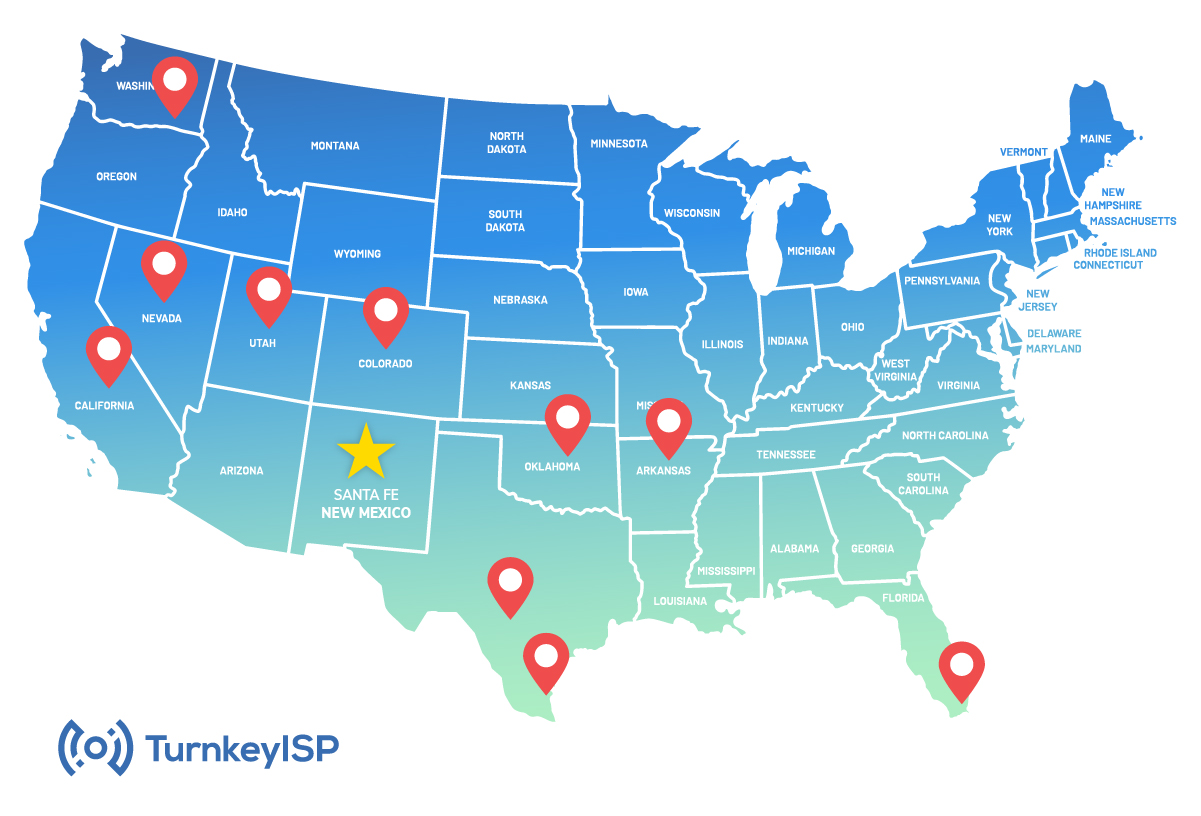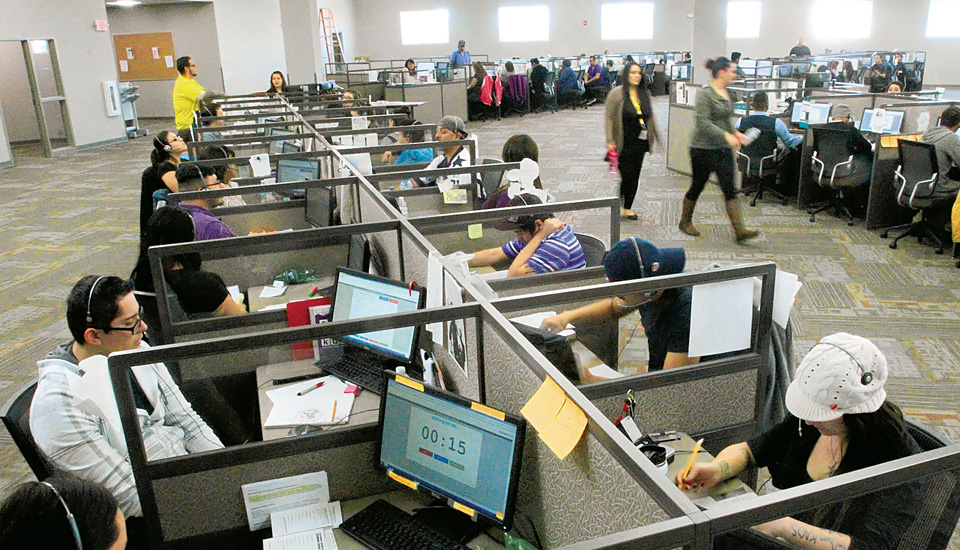- Published on
US-based ISP Call Centers in 2022
- Authors
- Name
- David Dean
- @mthoodlum
US-based ISP Call Centers in 2022
TurnkeyISP is a fully-remote call center for ISPs
TurnkeyISP is an ISP call center and remote staffing agency that was founded in Santa Fe, New Mexico USA at the start of the pandemic in the spring of 2020. We employ an English speaking workforce in the United States and around the world. English ability is our first and primary hiring criteria for ISP customer service representatives (CSRs,) technical support representatives (TSRs,) and billing specialists because we understand it is important to not introduce language barriers when communicating with ISP end-user customers who may already be frustrated.

Advantages of US-based call centers
There are 474,331 people employed in the telemarketing & call center industry in the US as of 2022 according to IBISWorld.
The primary reason telephone companies (telcos,) cable companies, competitive local exchange carriers (CLECs,) mobile network operators (MNOs,) wireless internet service providers (WISPs) and other internet service providers (ISPs) and communications service providers (CSPs) want US-based call centers and contact centers is to have access to workers who are native English speakers and have American accents. If a call center is based in the US then it is assumed that they will hire primarily native English speaking workers with local American accents.

When an internet customer calls their ISP for support, it is important to not introduce frustrations caused by language barriers and cultural differences because the ISP customer may already be frustrated by whatever problem caused them to call their ISP for support in the first place. ISP call centers advertise “US-based” as a shortcut to say “our workers have native American English accents and our call center won’t introduce frustrations caused by language barriers.”
While being US-based is helpful for marketing, advertising, and positioning, there are many reasons why I believe limiting call center operations to only a US-based workforce is a failed business model. Using the physical location as a primary selection criteria in the recruiting and hiring processes is unhelpfully limiting. It is inefficient and inaccurate and puts unnecessary constraints on call center operations. These inefficiencies were exacerbated by the COVID-19 pandemic which closed the central offices of call centers and forced them to go remote.
Frustrations caused by offshore call centers
Most Americans have experienced the frustration of offshore call centers from the customer perspective. We have a problem with a company’s products or services and we call the company for support only to reach a foreign customer service agent or remote technician at a call center who is not helpful. The agent is thousands of miles away, both literally and figuratively. The agent is difficult to understand, ambivalent to our problem, and unable to help. We naturally associate this bad experience with the foreign accent, but the root cause is not the foreign accent but rather an entire system that is broken and predestined to fail.

The root cause of the problem is not the physical location of the agent. The main problems were they were difficult to understand, ambivalent to our problem, and unable to help. TurnkeyISP focuses on fixing these problems and we do not use our physical location as a shortcut.
Oversubscription, it’s not just an ISP problem
One of the advantages to using a call center rather than in-house support is that a call center can average out the call volume amongst many clients, ISPs or otherwise. This is helpful when there is a local service outage because the call center may have the staff available to live answer every call during the outage. It would not be economical for a single ISP to maintain staff every day for rare events But by sharing staff amongst multiple clients, call centers can hire and maintain staffing levels based on average call volume across many clients
Sometimes an ISP will have an in-house team and only use the call center for overflow when the in-house team is busy. For example, if everyone on the in-house team is already on the phone and a new call comes in, then they could route the call to overflow at the call center. Or the ISP could give the in-house team three rings to answer but if they don’t answer, then the ISP could forward the call to the call center.

But an oversubscribed call center can be a huge problem if staffing levels are not maintained. Suddenly, instead of live answering during peak times, because of oversubscription, the call center will put ISP customers on hold even when the client call volume is light.
Similarly call centers can allow ISPs to provide extended hours and after hours phone support even if their current call volume does not justify staffing those times.
Scaling up your support team
Call centers can also allow an ISP to quickly scale up their support team because call centers are generally operating at a large scale than a single ISP. Hiring takes time and a call center may have the staffing levels to be able to handle quick market expansion, growth, and acquisition.
The 25 largest American call centers
https://info.siteselectiongroup.com/blog/25-largest-call-center-employers-in-the-united-states
Site selection group has compiled a list of the twenty five largest US-based call center companies along with the number of US workers employed. Here is that list:
| Rank | Company | Estimated Employees |
|---|---|---|
| 1 | Alorica | 47,298 |
| 2 | AT&T | 47,152 |
| 3 | Blue Cross Blue Shield | 40,832 |
| 4 | Wells Fargo | 40,622 |
| 5 | Verizon | 40,614 |
| 6 | Citigroup | 29,171 |
| 7 | Conduent | 28,874 |
| 8 | Bank of America | 28,144 |
| 9 | JPMorgan Chase & Co. | 26,108 |
| 10 | State Farm Insurance | 25,941 |
| 11 | Concentrix | 25,523 |
| 12 | GEICO | 24,710 |
| 13 | Teleperformance | 22,548 |
| 14 | Comcast | 17,940 |
| 15 | Spectrum | 15,908 |
| 16 | UnitedHealth Group | 15,423 |
| 17 | American Express | 14,430 |
| 18 | TeleTech | 13,394 |
| 19 | Sykes | 13,217 |
| 20 | Fidelity Investments | 13,060 |
| 21 | T-Mobile | 13,001 |
| 22 | Cigna | 12,308 |
| 23 | Aetna | 11,786 |
| 24 | Sitel | 11,523 |
| 25 | ADP | 11,374 |
Many of the largest call center companies are ISPs including multiple system operators (MSOs,) telecom companies, or LTE/5G mobile carriers. Other companies on the list include dedicated contact center companies, insurance companies, banks, and one accounting firm. Spectrum customer service and Xfinity customer service are both in-house and outsourced.
TurnkeyISP is an ISP focused call center and an ideal alternative to Alorica, Conduent, Concentrix, Teleperformance, TeleTech, Sykes, and Sitel for network operators and internet service providers.
Startup ISPs are local first
Startup ISPs are hyperlocal. For a new ISP it is difficult to compete with the incumbent ISPs on speed and price because the incumbent ISPs have deep pockets and the uses or has access to the same technologies that a startup ISP has access to. That means if a startup ISP can provide a 100 Mbps plan for $100 per month then the incumbent can probably do the same. The price and plan speeds of the incumbent providers is determined by the market conditions and the incumbent providers can easily adjust their offerings in a market to compete with a new market entrant, if they feel pressured to do so.
However, it is easy for a new ISP to compete with the incumbent providers by having local technicians, more responsive support, and higher quality ISP customer service. Sole proprietors and owner-operators often give their cell phone numbers to their early ISP customers. When an customer chooses the local ISP, they know they can reach someone when they have a problem and they know the local ISP will value their business and be responsive to their needs. This is something the incumbent internet service providers can’t do, because it doesn’t scale.
A hyperlocal approach is an example of what Paul Graham with Y Combinator wrote about in his article “Do Things That Don’t Scale.” Being hyperlocal is an advantage a new ISP can use to gain traction in their local market. When a subscriber has a problem they know they can reach out to a local person for support and that local person will be responsive. Unfortunately that is a process that only works when the ISP is small. Once the subscriber base grows then things that don’t scale start to break down.
ISP customers will reach out to the local team and the local team will be overwhelmed and not be responsive.
Physical location doesn’t matter
The physical location of a worker does not determine the quality of support they will provide to an internet subscriber. TurnkeyISP hires based on ability, including English ability, but not physical location. Some of our team members are based in the US and some are based outside the USA. “US-based” is a misleading proxy for “native English speakers.”
US-based call centers often employ non-native English speakers. Just because a call center is physically located in the USA says nothing about the English ability of their workforce.
Call centers: The support channel of last resort
ISP customers don’t like to call their service providers. They strongly prefer self-service and alternate channels of customer service and technical support when they are made available. Typical alternative channels include:
- Web self-service portal
- Knowledge bases
- Web chat support
- Phone apps
- SMS text messaging
- Community forums
Subscribers call their ISPs for billing, inbound sales, and technical support. In all three cases, if another support channel is available then the ISP customers would choose any of those channels over calling the ISP call center. Calling the ISP call center for support is often the support channel of last resort.
How do I call my service provider?
Another problem is that ISP subscribers can't use a web self-service portal if they don't have an internet connection and they can't call their ISP if they don't have phone service. If they bundle their phone and internet together or if you have a mobile phone with voice and data service and you have a problem, it can be difficult to get in touch with your service provider.
As a service provider you should search for your own business name and "phone number" to see if search engines suggest the right phone number to call. If ISP customers can't reach you through your perferred channels, then they are more likely to try to reach you through alternate channels or give up.
Some subscribers are very quick to leave an online review but most ubscribers will often only leave a review after they are motivated to do so. That motivation often comes in the form of a very bad experience that leads them to a breaking point. Sometimes it can be the frustrated caused by the inability to reach their service provider. For that reason TurnkeyISP recommends making your support channels available 24/7.
Types of call centers
There are three basic types of ISP call centers: Inbound, outbound, and blended. Any call or contact center which enables its agents to make outbound and inbound calls along with dealing with customer concerns across multiple channels is a blended call center.
Types of inbound calls include:
- Technical support
- Sales inquiries
- Customer service
- Contract renewals and retention
- Subscriber billing
Most outbound focused call centers are telemarketing focused and they make outbound sales related calls. But not all outbound call centers are telemarketing. Outbound calls include callbacks or returned calls such as reeturning disconnected calls, abandoned calls, voicemails, and performing follow-up satisfaction surveys. These are all common forms of outbound calls that do not necessarily involve outbound sales.
Anothe type of outbound call that is not telemarketing related an offline investigescalation.
Subscriber frustrations
What causes subscriber frustration and dissatisfaction
- Problems with their service, especially if chronic
- Inability to self-service
- No alternatives to dialing phone support
- No consistent phone number to call
- Customer unfriendly phone menus
- Long hold times
- Unfriendly security and verification processes
- Getting transferred, often multiple times
- Call quality issues
- CSRs who are unable or unwilling to help
- Call quality issues
Many technical support call centers are slightly glorified call answering services. The agents can take subscriber contact information, read from a script and ask the to perform simple steps like reboot the modem, and otherwise just escalate to the local team to respond.
Why are there no ISP call centers in Manhattan?
The average asking rent for Class A office space in New York City’s Manhattan was 79 U.S. dollars per square foot in the second quarter of 2021. Manhattan topped the list of most expensive urban areas in 2021 and the minimum wage there has been $15 per hour. This combination of factors makes Manhattan a cost prohibitive location to operate an ISP call center even though there is a large workforce
The federal minimum wage is $7.25 an hour, a rate that has not gone up since 2009. As the current wage stagnates, its purchasing power erodes against inflation. The average living wage today—defined as an income threshold that provides basic shelter and food and keeps a person above the poverty level—is $16.54, according to research from the Massachusetts Institute of Technology.
If you were considering opening a ISP call center or business process outsourcing (BPO) company, where do you think would be an ideal location? You would want access to a large labor force, inexpensive rent, and a low cost of living because your largest expense would be employee salaries.
Wherever you may choose, you probably would not choose Manhattan. Rent for office space alone makes Manhattan cost prohibitive. Related to the high cost of rent is the high cost of living. Your workforce would need to be able to afford living in or near New York City.
Popular states for call centers include Texas, Florida,
Employment law varies by state
There are federal, state, and local employment laws. According to the International Comparative Legal Guides, the main federal employment laws are: Title VIl (of the Civil Rights Act); the Americans with Disabilities Act; the Age Discrimination in Employment Act; the Equal Pay Act; the Fair Labor Standards Act; the Family and Medical Leave Act; the Immigration Reform and Control Act; the National Labor Relations Act; the Occupational Safety and Health Act, the Pregnancy Discrimination Act (PDA); the Uniformed Services Employment and Reemployment Rights Act; and Executive Order 11246 for government contractors. Many states have laws that mirror the Federal Laws. State common law, meaning precedent set by the courts, is also a significant driver of employment law issues.
There are 50 different employment laws in 50 different U.S. states because U.S. states have separate and individual employment laws. Call centers that are U.S. based need to navigate the complexities of complying with different employment laws in every state they operate in. If the call center hires an employee in a state then the call center needs to adhere to the employment laws of that state.
All 50 states have at-will laws but many states have various exceptions. 28 states have right-to-work laws including Arizona, Alabama, Arkansas, Florida, Idaho, Georgia, Indiana, Kansas, Iowa, Kentucky, Michigan, Louisiana, Mississippi, Nebraska, Missouri, Nevada, North Dakota, North Carolina, Oklahoma, South Dakota, South Carolina, Tennessee, Utah, Virginia, Texas, Wisconsin, and Wyoming.
What constitutes full-time, part-time over-time, holiday, breaks, vacation all potentially varies state by state.
COVID-19 introduced another legal minefield. Requirements vary not only by jurisdiction, but also by industry. Companies
The term at-will employment is a legal term meaning that an employer can terminate an employee for any reason without warning. However, an employer cannot fire an employee if the reason for doing so is illegal or discriminatory, such as firing someone because of their gender, race, or religion.
Contracts in at-will states between employers and employees prevent the employer from pursuing a claim against the employer due to being fired. In other words, an employee can not sue for lost wages due to dismissal from the job, provided the dismissal was legal, as discussed above. This law doesn't just apply to employers, though. In at-will employment states, employees can also quit their jobs or go on strike without having to provide an explanation. All 50 states in the U.S. and Washington, D.C. are at-will employment states. However, some states have exceptions.
Otherwise US-based call centers need to stay in one state and hire from limited, local talent pools.
American workers don’t want ISP call center jobs
Here are a few Glassdoor reviews for one US-based ISP-focused call center:
“I would rather loose my arm in a freak accident than ever have to work in that pit of despair again.”
Jul 27, 2021 - Wifi Assistant in Provo, UT
“minimum wage pay with bonus used to punish those who perform poorly” Feb 2, 2021 - Lead Technician
“Some of my trainers started only 2 days before me. This is a big red flag. They can't retain any of their employees” Sep 20, 2021 - Technical Support Agent LAN in Orem, UT
Call centers are not alone
ISP call centers face many of the same problems that many local ISPs face. There is a limited local talent pool and they need to compete for good employees with other enterprises, including competitive telecommunications providers. If a job is not sufficiently rewarding, both now and in the future, then good employees will move to better positions at bigger companies. Meanwhile the bad employees will stick around.
TurnkeyISP focuses on English ability, not physical location. We are not limited
The evolution of the call center industry
Before voice over internet protocol (VOIP) technology made it cost effective to relocate, almost all call centers were based in the USA if they were servicing customers in the USA. Once VOIP technology allowed call centers to handle calls affordably from anywhere in the world,